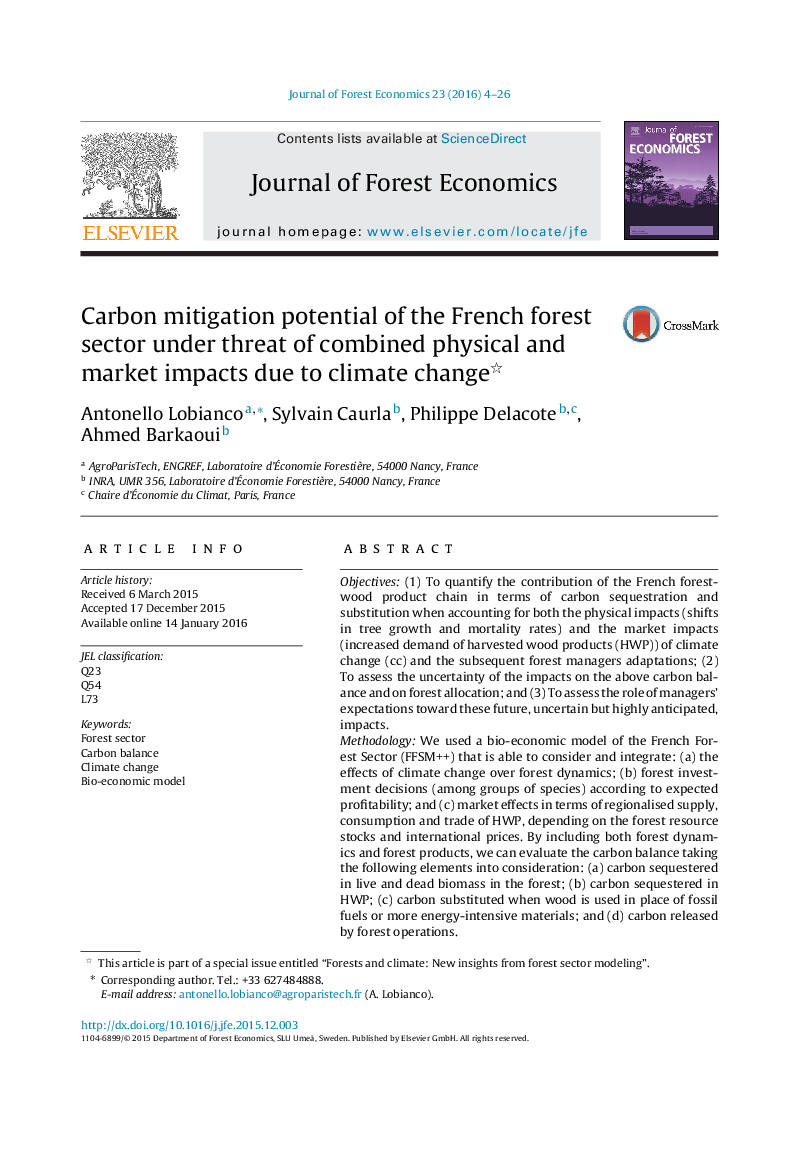| کد مقاله | کد نشریه | سال انتشار | مقاله انگلیسی | نسخه تمام متن |
|---|---|---|---|---|
| 91752 | 159842 | 2016 | 23 صفحه PDF | دانلود رایگان |
Objectives(1) To quantify the contribution of the French forest-wood product chain in terms of carbon sequestration and substitution when accounting for both the physical impacts (shifts in tree growth and mortality rates) and the market impacts (increased demand of harvested wood products (HWP)) of climate change (cc) and the subsequent forest managers adaptations; (2) To assess the uncertainty of the impacts on the above carbon balance and on forest allocation; and (3) To assess the role of managers’ expectations toward these future, uncertain but highly anticipated, impacts.MethodologyWe used a bio-economic model of the French Forest Sector (FFSM++) that is able to consider and integrate: (a) the effects of climate change over forest dynamics; (b) forest investment decisions (among groups of species) according to expected profitability; and (c) market effects in terms of regionalised supply, consumption and trade of HWP, depending on the forest resource stocks and international prices. By including both forest dynamics and forest products, we can evaluate the carbon balance taking the following elements into consideration: (a) carbon sequestered in live and dead biomass in the forest; (b) carbon sequestered in HWP; (c) carbon substituted when wood is used in place of fossil fuels or more energy-intensive materials; and (d) carbon released by forest operations.ResultsWhen the model is run at constant conditions for the next century, the average carbon potential of French forests is 66.2–125.3 Mt CO2 y−1, depending on whether we consider only inventoried wood resources, HWP pools and direct energy substitution, or if we also account for the carbon stored in tree branches and roots and if we consider the more indirect, but also largely more subjective, material substitution. These values correspond to 18.3% and 34.7%, respectively, of the French 2010 emissions (361 Mt CO2). However, when we consider both the probable increment of coniferous mortality and changes in forest growth, plus the rise in HWP demand worldwide, the average sequestration rate of the French forest decreases by 6.6–5.8% to 61.8–118.0 Mt CO2 y−1. Running partial scenarios, we can assess the relative interplay of these two factors, where the price factor increases the HWP stock while decreasing the forest stocks (where the latter effect prevails), while the physical impact of climate change reduces both, but to a lesser extent. Considering short-sighted forest managers, whose behaviour is based uniquely on the observed conditions at the time decisions are made, we obtain a limited effect of the overall carbon balance but a relatively large impact on the area allocation of broadleaved vs. coniferous species.
Journal: Journal of Forest Economics - Volume 23, April 2016, Pages 4–26
